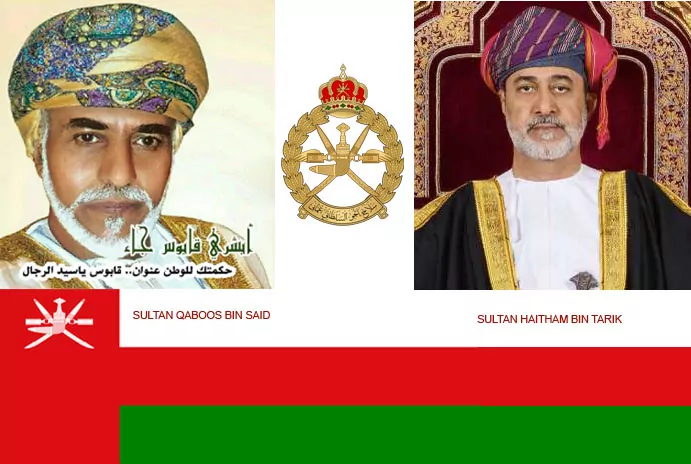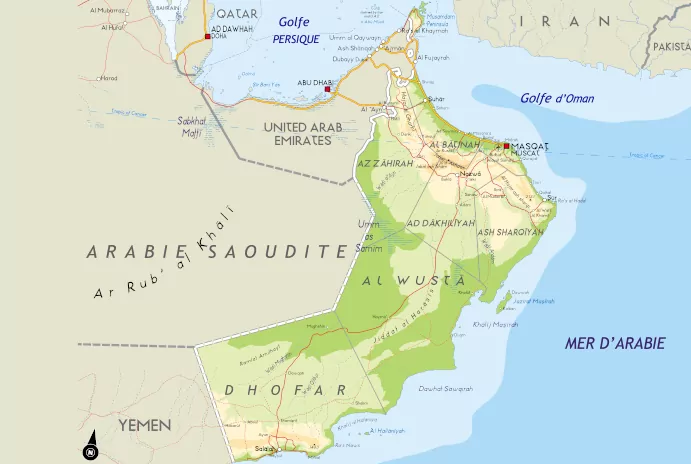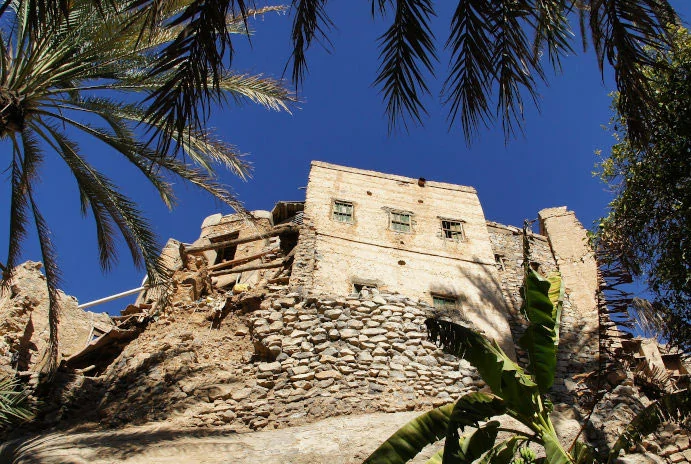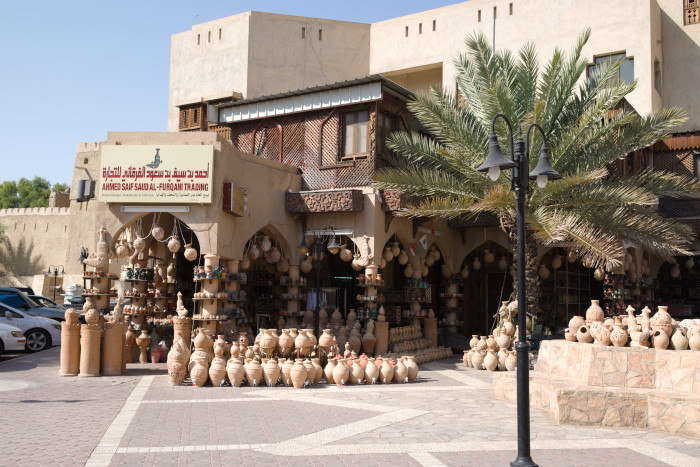Sultanate of Oman
Culture and modernity
-

A natural link between India and Africa, and a country of incense and skilled sailors, the Sultanate of Oman is rich in 5,000 years of history. The archaeological sites classified as UNESCO World Heritage Sites and its dozing fortresses in the shadow of peaks over 3000 meters are silent witnesses to this rich past.
- Head of state : His Majesty Sultan Haitham Bin Tariq
- Capital : Muscat
- Area : 309,500 km
- Religion : Islam
- Arabic is the official language
- Currency : Omani rial (OMR) (1 Omr = approximately 2,40€)
- Population : 5,000,772 million (Omani and residents). Omanis constituted 57.62 percent with 2,881,313 citizens. Residents constituted 42.38% with 2,119,459 citizens. - March 2023, National Center for Statistics and Information (NCSI).
The Sultanate of Oman.
The Sultanate of Oman is located in the southeastern part of the Arabian Peninsula, a region that the Romans called Arabia Deserta as opposed to Arabia Felix, the happy and green Arabia of Dhofar, on the borders of Yemen .
From north to south, the area is 309,500 km² presenting a contrasting relief composed of jagged or sandy coasts, mountains, plains and dunes. The country is made up of 6 regions administered directly by the government and two provinces (Dhofar and Moussandam) The variety of landscapes as well as the deposits of copper, gypsum, marble and, even rarer, green rocks called ophiolites, attract the attention of geologists and lovers of the great outdoors.
Oman is divided into two climate zones: the north and east have a Mediterranean climate, while the south and west benefit from a tropical influence with the arrival of the monsoon tails from June to September. The centre of the country has a desert climate. It's hot all year round with a monthly average of more than 25°C. There are only 2 seasons: summer (March to October) and winter (from November to February).
In mountainous regions the average annual rainfall is 300 mm. Daytime temperatures drop a few degrees and especially at night it can get cold. The rainiest months are November for Muscat and its surroundings and August/September for Salalah (Dhofar region).
The flora of Oman: given the extreme conditions of drought and the considerable temperature variations, the plant species are all very resistant. The "rain plants" are buried in the ground and take advantage of the slightest drizzle to grow. They are the ones to turn the desert green. The succulents and thorny plants, the plants that do not need any rain, are able to survive above ground all year round.
Among the animals to be found there are the houbara bustard, the thar (wild goat) and panthers. Antelope species (particularly small gazelles) live near oases and irrigated and cultivated areas. The area is also home to several bird species (larks, crows, bustards, owls, falcons).
Cultural life.
Oman is a tribal society, although tribal influence is gradually diminishing. Its predominantly Muslim ibaḍi population observes social customs that, while still conservative by Western standards, are considerably less strict than those in neighbouring Saudi Arabia. Women in particular have enjoyed relatively more freedom in Oman than elsewhere in the Arabian Peninsula.
Mealtime is the focus of most social gatherings. The typical Omani meal consists of rice, spiced lamb or fish, dates and coffee or tea. Incense, especially frankincense, is burnt at the end of the meal.
Omani craftsmen are renowned for woodcarving, weaving, pottery, goldsmithing and the making of daggers and swords. Their handicrafts are among the many items that can be found in the souk, or market, of Muscat, a thriving centre of folk culture. The Ministry of National Heritage and Culture is responsible for preserving historic buildings, excavating archaeological sites and supporting traditional crafts such as weaving and silver and gold jewellery making. It also promotes Omani literature and has printed an encyclopedia of Omani heritage.
The Museum of Oman (founded in 1974), located outside Muscat, is the country's main cultural repository; it tells the history of the country and includes exhibitions on Islam. The history of the Omani military is the focus of the Armed Forces Museum (1988). Other institutions include the National Museum (1978), the Natural History Museum (1983), the Children's Museum (1990) and Bait Nadir, a converted 18th-century residence that now houses Omani art and traditional artifacts, including jewellery, silverware, pottery and woodcarvings. The Royal Oman Symphony Orchestra was formed in the late 1980s and has performed with the BBC Philharmonic Orchestra; it is one of the few national orchestras in the Middle East.
Society
Oman is governed by a monarchy (sultanate) with two advisory bodies. The sultan is the head of state, and, although he also acts as the prime minister, he may appoint one if he chooses. The sultan is assisted by a Council of Ministers (Majlis al-Wuzara), the members of which he typically appoints from among Muscat merchants, informal representatives of interior tribes, and Dhofaris.
The Consultative Assembly, formed by the sultan in 1981, was replaced in 1991 by a Consultative Council (Majlis al-Shura), members of which were at first appointed and later elected from several dozen districts (wilayat); women from a few constituencies were given the right to serve on the council. In 1996 the sultan announced the establishment of the Basic Law of the State, the country’s first written constitution, which outlined a new system of government that included a bicameral legislature, the Council of Oman. In addition, it clarified the succession process and extended the right to serve to all Omani women. The Council of Oman consists of the Consultative Council as its lower chamber and, as the upper chamber, a new Council of State (Majlis al-Dawlah).
More than half of Oman’s population is Arab. However, large numbers of ethnic Baloch-who migrated to Oman from Iran and Pakistan over the past several centuries-live near the coast in Al-Baṭinah. The Muscat-Maṭraḥ urban area has long been home to significant numbers of ethnic Persians and to merchants of South Asian ancestry, some of whom also live along Al-Baṭinah. Notable among the latter are the Liwatiyyah, who originally came from Sindh (now in Pakistan) but have lived in Oman for centuries.
Several large Arab groups predominate along the coastal plain of Dhofar. The mountain dwellers of Dhofar are known as jibalis , or "mountain people". They are ethnically distinct from the coastal Arabs and are considered descendants of the highlanders of Yemen .
The population of Oman is primarily urban (84.5%) but has a number of traditional rural settlements(15.5%). These are typically located near the foothills of the Ḥajar Mountains, where the aflaj provide irrigation. In addition to small villages, a number of sizable towns, including Nizwā, Bahla, Izki, and Ibri, are found on the inland, or southwestern, side of the Western Ḥajar. Approximately one-fourth of the population lives in Al-Baṭinah. Al-Rustaq, Awabi, and Nakhl are principal settlements on Al-Baṭinah’s side of the Western Ḥajar.
Oman has one of the highest birth rates among the Persian Gulf states; this birth rate—combined with a relatively low death rate—has given the country a rate of natural increase that well exceeds the world average. Life expectancy averages about 75 years.
Oman is a rural and agricultural country, and fishing and foreign trade are important to coastal populations. Oil revenues account for about three quarters of government income.
In anticipation of the eventual depletion of oil reserves, the government in 1996 initiated a plan for the post-oil era that focused on developing the country’s natural gas resources to fuel domestic industry and for export in the form of liquefied natural gas (LNG).

- © 2024 - Orient Voyage- All rights reserved
-
Discover Omani frankincense


